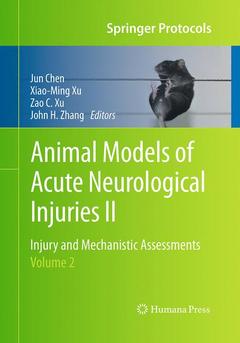Animal Models of Acute Neurological Injuries II, Softcover reprint of the original 1st ed. 2012 Injury and Mechanistic Assessments, Volume 2 Springer Protocols Handbooks Series
Coordonnateurs : Chen Jun, Xu Xiao-Ming, Xu Zao C., Zhang John H.

The successful previous volume on this topic provided a detailed benchwork manual for the most commonly used animal models of acute neurological injuries including cerebral ischemia, hemorrhage, vasospasm, and traumatic brain and spinal cord injuries. Animal Models of Acute Neurological Injuries II: Injury and Mechanistic Assessments aims to collect chapters on assessing these disorders from cells and molecules to behavior and imaging. These comprehensive assessments are the key for understanding disease mechanisms as well as developing novel therapeutic strategies to ameliorate or even prevent damages to the nervous system. Volume 2 examines global cerebral ischemia, focal cerebral ischemia, and neonatal hypoxia-ischemia, as well as intensive sections covering traumatic brain injury and spinal cord injury. Designed to provide both expert guidance and step-by-step procedures, chapters serve to increase understanding in what, why, when, where, and how a particular assessment is used.
Accessible and essential, Animal Models of Acute Neurological Injuries II: Injury and Mechanistic Assessments will be useful for trainees or beginners in their assessments of acute neurological injuries, for experienced scientists from other research fields who are interested in either switching fields or exploring new opportunities, and for established scientists within the field who wish to employ new assessments.
Introduction (Parts I-III).- Morphological Assessments of Global Cerebral Ischemia: Viable Cells.- Morphological Assessments of Global Cerebral Ischemia: Degenerated Cells.- Morphological Assessments of Global Cerebral Ischemia: Electron Microscopy.- Biochemical and Molecular Biological Assessments of Global Cerebral Ischemia: mRNA.- Biochemical and Molecular Biological Assessments of Global Cerebral Ischemia: Protein.- Neurobehavioral Assessments of Global Cerebral Ischemia.- Assessment of Neurogenesis in the Dentate Gyrus after Global or Focal Ischemia.- Infarct Measurement in Focal Cerebral Ischemia: TTC Staining.- Morphological Assessments of Focal Cerebral Ischemia: White Matter Injury.- Blood Flow Reduction: Laser Doppler, 14C-IAP.- Biochemical and Molecular Biological Assessments of Focal Cerebral Ischemia: mRNA and MicroRNA.- Biochemical and Molecular Biological Assessments of Focal Cerebral Ischemia: Protein.- Assessments of Inflammation After Focal Cerebral Ischemia.- Neurobehavioral Assessments of Focal Cerebral Ischemia: Sensorimotor Deficit.- Neurobehavioral Assessments of Focal Cerebral Ischemia: Cognitive Deficit.- Assessment of Neurogenesis in Models of Focal Cerebral Ischemia.- Assessment of Angiogenesis in Models of Focal Cerebral Ischemia.- Morphological Assessments of Neonatal Hypoxia-Ischemia: In Situ Cell Degeneration.- Morphological Assessments of Neonatal Hypoxia-Ischemia: White Matter Injury.- Biochemical and Molecular Biological Assessments of Neonatal Hypoxia-Ischemia: Cell Signaling.- Biochemical and Molecular Biological Assessments of Neonatal Hypoxia-Ischemia: Inflammation.- Neurobehavioral Assessments of Neonatal Hypoxia-Ischemia.- Assessment of Neurogenesis and White Matter Regeneration.- Assessments for Traumatic Brain Injury: An Introduction.- Morphological Assessments of Traumatic Brain Injury.- Assessment of Cerebral Vascular Dysfunction after Traumatic Brain Injury.- Assessment of Membrane Permeability After Traumatic Brain Injury.- Assessment of Neurogenesis by BrdU Labeling After Traumatic Brain Injury.- Electrophysiological Approaches in Traumatic Brain Injury.- Biochemical and Molecular Biological Assessments of Traumatic Brain Injury.- Assessments of Oxidative Damage and Lipid Peroxidation after Traumatic Brain Injury and Spinal Cord Injury.- Neurobehavioral Assessments of Traumatic Brain Injury.- Vestibular Assessments Following Traumatic Brain Injury.- Introduction on Assessments for Spinal Cord Injury.- Morphological Assessments Following Spinal Cord Injury.- Assessment of Lesion and Tissue Sparing Volumes Following Spinal Cord Injury.- Retrograde Axonal Tract Tracing.- Anterograde Axonal Tract Tracing.- Assessments of Gliogenesis After Spinal Cord Injury.- Assessing Microvessels After Spinal Cord Injury.- Physiological Assessment of Spinal Cord Injury.- Electrophysiological Assessment of Spinal Cord Function on Rodents Using tcMMEP and SSEP.- Operant Conditioning of Spinal Cord Reflexesin Rats.- Cellular and Molecular Biological Assessments of Inflammation and Autoimmunity After Spinal Cord Injury.- Neurobehavioral Assessments of Spinal Cord Injury.- Basso, Beattie, and Bresnahan (BBB) Scale Locomotor Assessment Following Spinal Cord Injury and Its Utility as a Criterion for Other Assessments.- High Speed Video Recording Used for the Analysis of Hand Shaping in Over Ground Walking, Cylinder Exploration, Skilled Reaching, and Rung Walking in Rats.- Automated Gait Analysis Following Spinal Cord Injury.- Forelimb Functional Assessments of Rats and Mice After Cervical Spinal Cord Injury.- Swimming as an Assessment of Hindlimb Function in Animals with Traumatic Spinal Cord Injury.- Neuroimaging Assessment of Spinal Cord Injury in Rodents.
Date de parution : 08-2016
Ouvrage de 718 p.
17.8x25.4 cm
Date de parution : 04-2012
Ouvrage de 718 p.
17.8x25.4 cm



